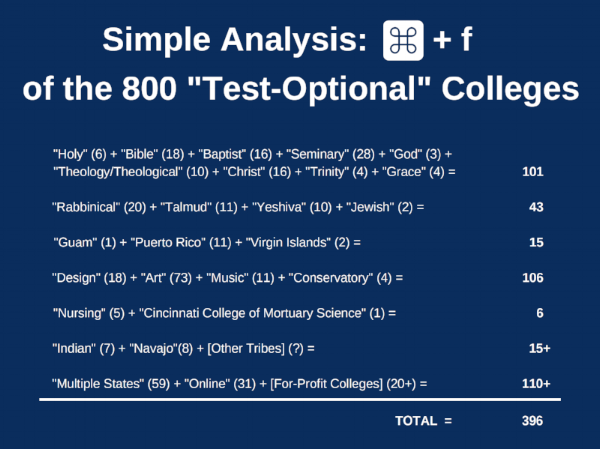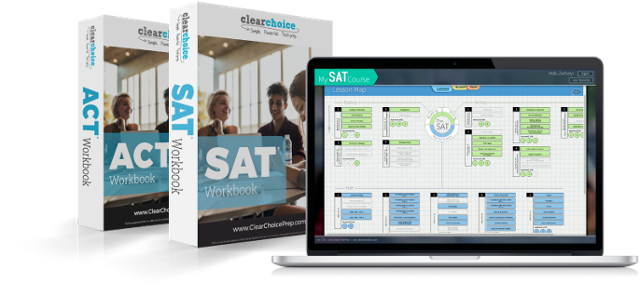Will the Test-Optional "Trend" Catch on?
Will test-optional admissions be as big of a hit as the accordion pants fad?
Updated on June 26, 2023
When Exactly Did the “Test-Optional Trend” Begin?
From the earliest attempts to rank students, there's never been a consensus on exactly how valuable standardized tests actually are. Even so, most reasonable people concede standardized tests are at the very least a necessary evil in college admissions.
There are exceptions to this rule. The admissions department at Hampshire College, for example, makes a reasonable sounding argument that it simply has no need for the SAT® or ACT®. Still, they don't condemn the tests or even suggest that every school should drop them as a requirement.
For some perspective, Hampshire College "dropped the test" in 1970. In reality, it never adopted the test; 1970 was the year Hampshire College was launched "as an experiment in alternative education." In the decades since, a handful of schools—mostly small liberal arts colleges—have followed suit.
I mention the size of those schools because going test optional appears only to be viable for very small schools. For example, Hampshire College reported a total enrollment for 2016-2017 of 1,321 students—with an incoming class of just 327 freshmen. These aren’t numbers that move the needle in college admissions as a whole.
But I've heard so much about this "trend..."
Yeah, we all have. But what exactly are these claims based on?
The test-optional trend goes all the way back to Bowdoin College in 1969. Then Hampshire College went "test blind" in 1970. Bates went test optional in 1984. Then a very long time passed. Not much happened.
Then, in 2014—a full 30-years later—a handful of highly selective colleges, including Wesleyan, Bryn Mawr, and George Washington University, made the move to test optional. Still, the remarkable thing is how few schools have elected to ignore or even de-emphasize the data provided by SAT® and ACT®. That hasn't stopped stories like this Washington Post article from making the rounds every few months.
The WaPo article is much better than most of the coverage on the topic—that's why I've linked to it as opposed to sending you directly to the oft-quoted, uber-biased, go-to source for all things anti-test. True to form, this particular source is still promoting a massively inflated list of 4-year colleges that do not explicitly require SAT® or ACT® scores.
Why do I say it's massively inflated? Well, allow me to share this super basic vetting exercise performed about two years ago (when it only claimed to have 800 colleges):
Casual Observations on the List of Test-Optional Schools:
1. I'm not suggesting that students should not consider religious schools. It's just that they're not for everyone. And religious schools that aren't based on your religion are almost certainly not for you.
2. The WaPo article above only felt comfortable listing 275 colleges from the source's list. That’s a significant credibility gap when you’re claiming to have a list of 1000 schools.
3. There are undoubtedly some good schools that students can attend without taking the SAT® or ACT®. But the larger point remains that advising a student to skip the SAT® and ACT® is essentially college counseling malpractice. The simple fact is this: choosing not to take the SAT® or ACT® will severely limit a student’s options. There can be no disputing that fact.
Despite all the above, bloggers across the internet have uncritically relied on this biased and misleading information. Personally, I suspect that's because the site is run by aggressively self-promoting policy entrepreneurs. And while it's not inherently a bad thing to make your living off of advocating for a cause, that can be mistaken for the mark of an unbiased analyst. If anything, it's quite the opposite. Which brings me to the last item on the list:
4. For-profit colleges should NOT be listed on the same list as legit four-year schools. Choosing to include for-profit colleges on this list a telling choice. Think about it. The author of the list chose to include a bunch of for-profit schools—a number of which are currently facing lawsuits for allegedly defrauding students. The list’s creator is hyper-critical of the SAT®’s non-profit status, yet the author chose, for personal convenience, to endorse a bunch of highly questionable for-profit schools by positioning them along side a list of legit four-year schools. For an organization that claims to advocate for students to endorse a bunch of dubious institutions in order to pad it’s own stats… that’s just… wow.
(Note: I'm in the business of providing custom-branded test-prep curriculum, software, and consulting to test-prep tutors across the U.S. and around the world. If you're reading this, you’re no doubt already aware of that fact, but I figured it was worth mentioning in the interest of full disclosure. Still, I’m not pretending for a moment to be an objective observer in all of this.)
Why Hasn’t Every School Dropped these Awful Tests?
If everything we’ve heard about the SAT® and ACT® are true, then why would anyone still use them as part of their college admissions practices?
Ultimately, the vast majority of colleges and universities still see a place for assessments like the SAT® and ACT®. While the list of test-optional schools has grown a bit in recent years, the reality is that all colleges really like data. And some of the best data, according to the colleges themselves, is provided by the SAT® and ACT®.
That makes sense. It's incredibly difficult to weigh candidates against each other based solely on anecdotal and qualitative criteria like essays, resumes, and high school transcripts. And going forward, it may be increasingly risky from a legal standpoint to rely on these subjective measures. Simply put, entrance exams like the SAT® and ACT® provide quantitative scores that provide an additional way to help compare Student X and Student Y.
Test scores alone do not adequately define the potential of each student, but they can help admissions officers make a decision. For that reason, schools, like Ball State and many others nationwide, have opted to go “test optional” rather than refusing to accept test scores outright.
I Thought “Test Optional” Meant Applicants Don’t Submit Test Scores?
You could be forgiven for jumping to that conclusion, especially given the press releases of those championing the move. But just because applicants aren’t required to submit test scores doesn't mean the best candidates among them won’t choose to submit SAT® and ACT® scores regardless of the change. And why wouldn’t they? They’re pretty smart, after all.
They know that a high score on the SAT® or ACT® can do a lot to bolster an already strong application—even when applying to a test-optional school. Returning to the example of Ball State, we can see that the majority of applicants still submit SAT® and/or ACT® scores.
Source: BSU 2017-2018 Common Data Set
This data above is not an anomaly. Students across the country have stubbornly continued to submit test scores to schools, despite some schools having moved to test-optional admissions. And why is that? Because if you've got a good test score, you're going to send it to every test-optional school to which you apply. Oddly, that's not a trend you hear much about, is it?
What Happens Next?
The College Board’s summer of PR blunders doesn't mean you should plan to shutter your test-prep business this fall. Take this summer's news for what it is. College Board went 0-for-2 on summer SAT® administrations. First, it seemingly cut corners on workshopping the content for the June SAT®. Then, it either A) made a careless mistake by reusing an old test, or B) lacked the confidence that the next test in the chute was adequately calibrated, and opted instead to administer a test it knew had performed well—last fall.
Whatever the case, these are not mistakes that College Board should be making at this stage in the game. Standardized tests should, above all else, be standardized. College Board should not be committing unforced errors on this scale. As a result, all eyes were on College Board this fall to see whether the October 6, 2018 SAT® would mark a return to form—or a return to a previously administered test form.
It appears that College Board has righted the ship. Social media was mostly crickets following the October SAT®. Zero news outlets have reported widespread complaints about test irregularities or test site security breaches. Perhaps now College Board can put all of this behind them. However, another headline-grabbing misstep during the heart of college application season would no doubt bring attention to college admissions policy entrepreneurs, and seed yet another cycle of single-sourced online articles that rely heavily on the testimony of SAT’s® most vocal critics. Worse for the College Board, another blunder could reverse the momentum toward institutional adoption that the SAT® has enjoyed since its 2016 redesign.
Keep an Eye on the University of California Study
California was, until very recently, considering AB-1951 Pupil assessments: Pathways to College Act, which would:
... require, pursuant to specified provisions of the federal Elementary and Secondary Education Act, the Superintendent of Public Instruction to approve a nationally recognized high school assessment that a local educational agency, as defined, may, at its own discretion, administer, if the alternative assessment is approved by the local educational agency’s governing board or body in a public meeting, commencing with the 2020–21 school year, and each school year thereafter, in lieu of the consortium summative assessment in English language arts and mathematics for grade 11.
At the end of September, California Governor Jerry Brown vetoed the idea. Brown’s veto is widely seen as an effort to protect the Smarter Balanced tests, a signature accomplishment of Brown’s longtime Education Secretary, Michael Kirst. Brown suggested that the UC and CSU systems should consider adopting the Smarter Balanced tests as part of its admission criteria. The chairman of UC’s Academic Senate has announced (without details) a study will be conducted.
The results of that study could go a long way toward validating or undermining the use of SAT® and ACT® scores in college admissions. Keep an eye on this.
What Does All of This Mean For Your Test-Prep Company?
With confidence in the SAT® having taken a very public hit, ACT® will likely have some new takers in the upcoming testing cycles. If you haven't already done so, make sure you’ve implemented the best ACT® prep curriculum available. We’ll be happy to help you get started.
For its part, ACT seems to have a renewed sense of purpose, at least as far as its weekly newsletter is concerned. Even a casual reader can see that ACT has decided to emphasize its innovation, validity, and partnerships that will enable it to move toward a computer-based test in the not too distant future.
Now, more than ever, it will be essential to stay informed. The last thing you want is to learn these types of stories in your competitors' blogs—or worse, from parents who call you with questions about college admissions.
Making sure you're prepared to provide test prep for either major test isn't just prudent; it may prove to be essential. Fortunately for you, Clear Choice Test Prep has you covered!
Next Steps?
For our part, we'll keep rolling out articles to keep you in the know. We hope you’ll consider subscribing to our blog. We'll do our best to keep you up to date on the latest news, trends, and developments in the world of test prep and college admissions!





